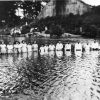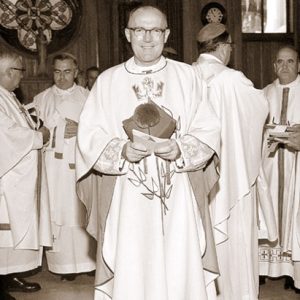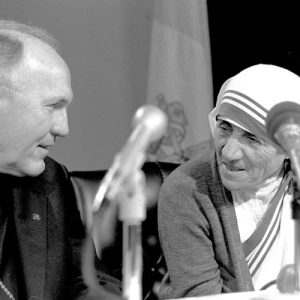calsfoundation@cals.org
Andrew Joseph McDonald (1923–2014)
Andrew Joseph McDonald served as the fifth Roman Catholic bishop of Little Rock (Pulaski County)—a diocese that encompasses the boundaries of the state of Arkansas—from 1972 to 2000. During his tenure, the Catholic Church in Arkansas witnessed significant growth. In 1970, Catholics numbered 55,283 (or 2.8 percent) out of a total state population of 1,923,000. However, in the 1990s, the number of Catholics in Arkansas ballooned, and by 2000, they constituted 93,480 (or 3.4 percent) out of a total state population of 2,643,400. This growth was fed mainly by Catholics from other states retiring to Arkansas, coinciding with a Hispanic influx, primarily from Mexico.
Andrew McDonald was born on October 24, 1923, in Savannah, Georgia, the eleventh of twelve children of James Bernard McDonald and Theresa McGreal McDonald. After attending the cathedral parish school, McDonald was sent to a minor seminary in Cantonsville, Maryland, just shy of his fourteenth birthday. For the next decade, his theological training was in and around Baltimore, Maryland. On May 8, 1948, McDonald was ordained a priest for the Diocese of Savannah. After ordination, McDonald attended the Catholic University in Washington DC and the Lateran University in Rome. Upon receiving a doctorate in canon law in Rome in 1951, McDonald worked in the Chicago, Illinois, archdiocese before returning to Savannah in 1952. For twenty years, McDonald served in various parishes around his native city. On June 11, 1972, he was notified of his appointment as Arkansas’s next Catholic prelate. On September 5, 1972, McDonald was consecrated the fifth bishop of Little Rock at St. John the Baptist Cathedral in Savannah.
McDonald’s predecessor, Bishop Albert L. Fletcher, had instituted, in the wake of Vatican II, parish councils, homes for lower-income families, and new ecumenical communications; these were all expanded under McDonald. The Catholic diocese partnered with Arkansas’s Episcopal and Methodist dioceses to create the Good Shepherd retirement homes and an interfaith hunger task force, as well as to arrange for Catholic membership in the Arkansas Council of Churches and Synagogues in 1983.
McDonald’s era is mainly noted for the many changes that affected Arkansas Catholicism. In December 1972, the Diocese of Little Rock was moved from the New Orleans, Louisiana, province and placed in a new one based in Oklahoma City, Oklahoma. McDonald redecorated and renovated St. Andrew’s Cathedral in Little Rock during the 1970s (though not all were happy with the results), began an office to minister to the growing Hispanic population, and instituted the permanent diaconate program in 1978. He appointed more laypersons into the diocesan administration. Fred and Tammy Woell of Little Rock founded the Little Rock Scripture Study program in 1974. Bishop McDonald endorsed the program in 1977, and, by 1986, a major Catholic press was distributing its materials nationwide and, eventually, worldwide. In 1982, John Michael Talbot, an internationally known Catholic singer/songwriter, relocated to Eureka Springs (Carroll County) to found the Little Portion Hermitage, a Franciscan community sanctioned by McDonald in 1990. On June 2, 1982, McDonald welcomed Mother Teresa of Calcutta, India, to a prayer rally at Ray Winder Field to herald the introduction of her Missionaries of Charity to Arkansas. Her sisters opened Abba House, a home for unwed mothers, in Little Rock. The Arkansas bishop added an adoption service to Catholic social services two years later. During the 1980s, he renovated the buildings at the old St. John’s Seminary for diocesan offices and for a priest retirement home.
In his last decade as bishop, McDonald commemorated the sesquicentennial of the creation of the Arkansas diocese on November 28, 1993; one aspect of this milestone was the publication of the first history of Arkansas Catholicism. The celebration culminated with a Mass at the Little Rock Convention Center on November 6, 1994, an event attended by twenty-nine other Catholic prelates, including Archbishop Agostino Cacciavillan, apostolic pro-nuncio for the United States. A year later, a new building near St. Andrew’s Cathedral was dedicated as McDonald Hall, the only building so-named in the diocese. McDonald observed his twenty-fifth anniversary as bishop in September 1997 and, nine months later, his fiftieth anniversary as a priest. On October 24, 1998, as required by canon law, he submitted his resignation on his seventy-fifth birthday. He remained as bishop until the pope named his successor, J. Peter Sartain, in January 2000. On March 6, 2000, Sartain was ordained Arkansas’s sixth Catholic bishop.
McDonald remained in Arkansas for two years before relocating to Chicago to serve as a chaplain for the Little Sisters of the Poor retirement center. He died on April 1, 2014, at the St. Joseph Home for the Elderly in Palatine, Illinois, and was interred at St. Andrew’s Cathedral in Little Rock.
For additional information:
Archives of the Catholic Diocese of Little Rock. St. John’s Catholic Center, Little Rock, Arkansas.
Woods, James M. Mission and Memory: A History of the Catholic Church in Arkansas. Little Rock: August House, 1993.
James M. Woods
Georgia Southern University
 Divergent Prosperity and the Arc of Reform, 1968–2022
Divergent Prosperity and the Arc of Reform, 1968–2022 Religion
Religion Andrew McDonald
Andrew McDonald  Andrew McDonald
Andrew McDonald  Mother Teresa Press Conference
Mother Teresa Press Conference 




Comments
No comments on this entry yet.